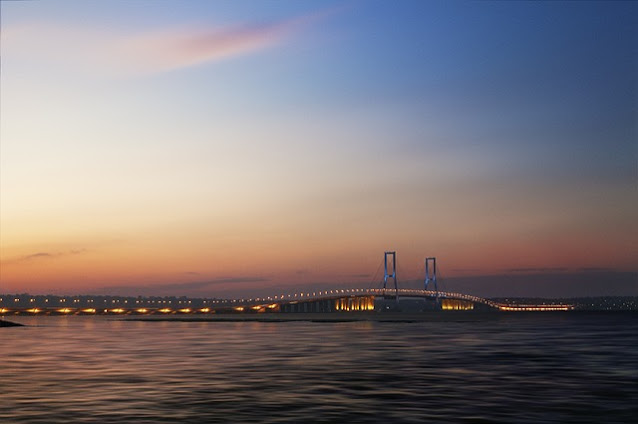The Definition of Bridge, Parts of the Bridge, and Types of the Bridge.
The bridge is one of the constructions or buildings that we often encounter in everyday life.
However, it turns out that not all bridges are the same and bridges have various types according to their classification. Let's take a look at the Definition of Bridge, Parts of the bridge, and types of the Bridge.
 |
| The Definition of Bridge, Parts of the Bridge, and Types of the Bridge. |
Definition of a Bridge
According to American Association of State Highway and Transportation Officials (AASHTO:2017),
A bridge is Any structure having an opening not less than 20.0 ft that forms part of a highway or that is located over or under a highway.
Parts of Bridge
The bridge-building generally consists of 3 main parts/ components:
1. Upper Building/ Superstructure Component
The superstructure consists of a building that functions to bears the load passing over it. The upper building/ superstructure consists of:
a. Girder
A girder is a beam between two supports which can be a pier or an abutment on a bridge or a flyover.
b. Decks/ plate
Decks supported by the girders. The road or rail at the surface of the bridge is called decking.
2. Lower Building/ Substructure Component
The lower building/ Substructure Component is a system/part that functions to support the upper building. The lower building consists of:
a. Abutment
The abutment is a bridge pillar at the end of the bridge above the oprit. The function of the abutment is to retain the earth behind the structure and to support the loads from the superstructure.
b. Piers
Piers are vertical structures of a bridge. It has a function to support the deck, and transfer the load from the superstructure to the foundation.
c. Wing wall
The wing wall is an extension of the abutments.
d. Bridge foundation.
Foundation has the function to transfer the load from the piers and abutments to the soil.
3. Complementary Buildings
The complementary building consists of:
a. oprit
b. bridge safety
c. road/river safety buildings
d. drainage elements and others.
For those who find it difficult to imagine the parts above, you can see the image below:
 |
| Parts of Bridge |
Types of Bridges
Bridges have several types based on the shape of the structure on them, time of use, function, span length, and construction materials. Here are the types of bridges:
Bridge Type Based On the Shape of The Upper Structure
1. Stone arch bridge
2. Truss bridge
3. Concrete bridge
4. Suspension bridge
5. Cable-stayed bridge
Bridge Type Based On the Time of Use
1. Temporary / emergency bridges
2. Semi-permanent bridge
3. Permanent bridge
Bridge Type Based On Construction Materials
1. Concrete bridge
2. Steel bridge
3. Wooden bridge
4. Bridge composite material
Bridge Type According to Its Function
1. Highway bridge
2. Rail bridge
3. Gutter bridges or reservoirs
4. Bridge for pipe crossing
Bridge Type Based On Span Length
1. Short span (<20 m)
Bridges with reinforced concrete, generally only used for short bridge spans that have a length of 6 -20 m.
The types that are usually used include the Slab Bridge, T-Girder, and I-Girder. An example can be seen in the image below.
 |
| Bridge with reinforced concrete |
2. Medium span (20 m - 100 m)
Until now, the use of steel trusses for bridges still dominates medium span bridge buildings.
The type of steel that is usually used is the Truss bridge. However, you can also use Prestressed Box Girder, PCI-Girder types and you can also use composite materials with the Composite bridge type.
Truss bridge example can be seen in the image below.
 |
| Truss Bridge |
3.Long span (> 100 m)
Long span bridges usually use a hanging system to withstand the weight of the bridge floor.
Which is a long span bridge, including steel and concrete arching bridges, suspension cable bridges, and cable-stayed bridges.
Arch bridges generally have a main span between 90 meters - 200 meters.
The arch becomes a place to hang/support the floor of the bridge in the form of tubular steel or reinforced concrete.
Floor hangers are generally made of steel while the supports can be made of reinforced concrete or steel.
The cable-stayed bridge has a span ranging from 150 meters - 500 meters.
The floor system of the bridge is supported by cables that are directly connected to the tower.
Suramadu Bridge and Pasupati Bridge apply cable-stayed system.
 |
| Suramadu Bridge apply cable-stayed system |
Bridges with spans that are very long or greater than 400 meters, usually use a suspension cable system to carry the load on the bridge floor.
This bridge system has a plate hanging cable as well as the main cable which functions to transmit the load to the pillars and then forward to the foundation.
I think thats all for The Definition of Bridge, Parts of the Bridge, and Types of the Bridge. Please comment and share. Thanks. ☺
Source: Manual Petunjuk Teknis Pengujian Tanah, Direktorat Jenderal Bina Marga,Kementerian PUPR
Post a Comment for "The Definition of Bridge, Parts of the Bridge, and Types of the Bridge."